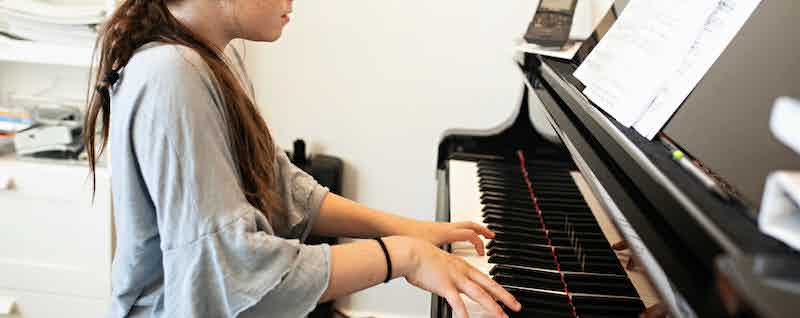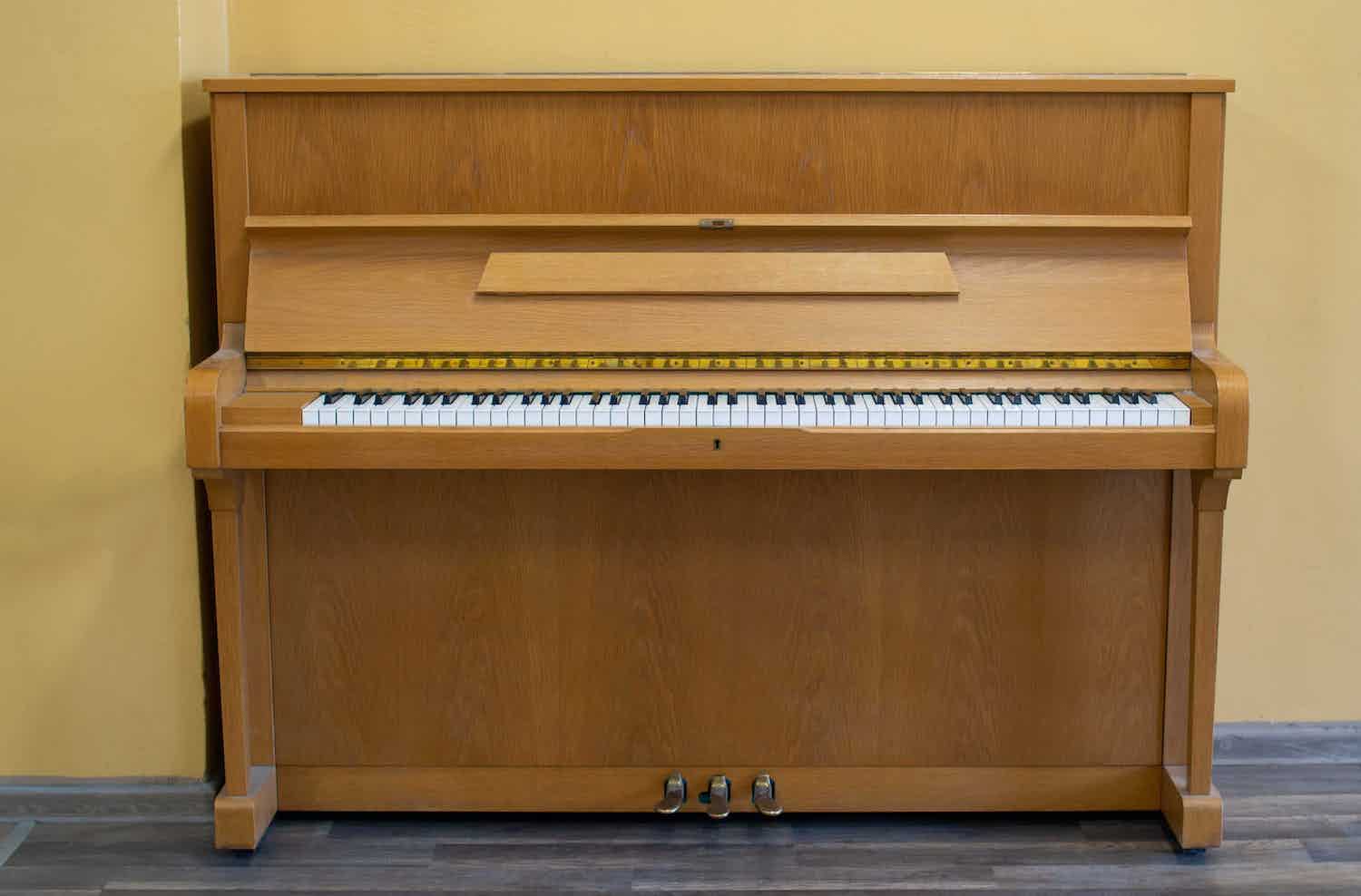Adults taking piano lessons often wonder how much of their practicing time should be devoted to playing exercises and how much time to devote to playing pieces. Questions such as “How can I divide my practicing time?” or “How much time should I spend on exercises?” are common for piano students.
These are great questions. We’d like to share a couple insights about how to divide your piano practice time or organize your practice sessions so that you get the most out of the time you spend at the piano. We work with adult piano students every day, so if you would like to schedule piano lessons in New York City, we would love to hear from you. We offer in-studio and in-home piano lessons in Manhattan, as well as in-home lessons in Brooklyn and Queens.

Keep Your Interests in Mind When Organizing Your Practice
Why are you playing the piano? Whether you are taking piano lessons or learning on your own, what is your objective?
First things first: if you are playing strictly for enjoyment of the music, then it makes sense to set songs you want to play as a a priority during the time you spend at the piano.
In that case, while working on a piece or a song, if you find your technique to be not quite developed enough to play the piece to your satisfaction, spend some time thinking about specifically which aspects of your technique could use a bit of improvement. This is where a thoughtful teacher can be tremendously helpful. After you’ve figured out what aspects of your technique could use a bit of work, devote some time to improving those aspects of your technique.
When it comes to working on specific aspects of your technique, mindfully playing exercises can be very helpful. If the idea of playing exercises seems boring to you, know this: there are many, many exercises that are musical and very enjoyable to play! ‘Playing exercises’ does not mean mindlessly drilling scales (though, even scales can, and should be played musically and intentionally — but that is another topic).
Keep in mind that in order to develop technique, you really have to practice regularly (more on that, later).
Additionally, you need to practice your music well. It’s fine to prioritize the music you want to play, but following a meaningful practice strategy:
- Never play a section faster than you can play it accurately
- Don’t cheat by skipping notes (“ghosting” notes), ignoring dynamics, using bad technique, playing unevenly, etc.
- Don’t forget to practice with a metronome
- Practice 1-3 measure chunks of the music, then when you have perfected that section combine it with another section
- Practicing hands separately can be a great idea
There are so many more tips than this that a qualified piano teacher in Manhattan or elsewhere in NY could help you with.

Keep Specific Goals in Mind While Practicing
First things first — when thinking about how to structure your piano practice sessions, it can be really helpful to have specific goals and objectives in mind. All the more so if you are learning on your own rather than working with an instructor! You might want to be able to play a particular piece by a certain date, for example. Or maybe you are working on being able to play a piece more fluently. Perhaps you want to smooth out a challenging passage.
Whatever your objective, think of it before you sit down to practice. It can be very helpful to keep a small journal near the piano, where you write down what you worked on each day and what you intend to work on next time you practice.
Set Apart Piano Practice Time – Consistently and Often
If you want to learn how to play the piano, you’ll need to commit to regular practice. It doesn’t need to be for several hours every day, but you do need to practice often.
The Importance of Consistency
As an adult interested in playing piano, you probably have experience taking tests or exams in your academic past. If that’s the case, you understand the pitfalls of cramming. The same applies to learning a language
You will never be “fluent” in a discipline, or achieve a level of consistent proficiency, if you practice the piano, for instance, every Saturday for two hours, followed by six days away from the piano.
Prioritize practicing the piano every day, with only rare exceptions. If you are traveling, study your notes or your music. You can do at least do something for a few minutes every day.
How Long Do Your Practice Sessions Need to Be?
If you are a beginner, 20 minutes or so each day is a great place to start. If you are highly motivated you can practice much longer of course, but you will make rapid progress with daily 20 minuted sessions.
As your pieces and exercises get a bit longer, you will need 30-40 minutes to achieve a comprehensive practice session. That’s because you’ll be studying some theory or concepts, drilling technique, practicing sight reading, and learning a piece of repertoire.
As you become more advanced, your sessions will be determined by your goals, the challenging nature of your music, and your schedule. It is advised that you break your practice up into 25-30 minute chunks, either spread throughout the day, or with breaks in between.
How Often Should You Practice Technique on the Piano?
If you have a specific interest in technique development, it’s helpful to very intentionally devote some part of your practice sessions specifically to that task. If you are serious about developing your technique, it is helpful to be more intentional about dividing your practicing time.
Developing your technical skills at the piano requires regularity. There’s no way around that. If you want to develop your technique, you have to work on it regularly (and mindfully!).
Keep in mind: how you divide your piano practice sessions should depend on what it is you’d like to achieve, and on your own individual needs. With that in mind, here are some ideas for dividing your practice time.
Technique Once Per Week
To see real progress, it’s better to work on technique more regularly, at least a few days per week. However, again, depending on your objectives, you can spend, for example, one day a week working specifically on technique, and the other days playing whatever you want to play (strictly for enjoyment).
Technique for Part of Session
You might devote part of each practice session specifically to working on technique. If you practice about an hour or so per day, you might consider spending 30 mins on technique, and 30 mins on pieces.
Alternate Days
Another option is to alternate days, working only on pieces one day, only on technique the next day, only on pieces the following day, and so on.
Regardless of how you choose to divide your practicing time, always remember that there is no single right way to organize your time. How you do so, depends on your individual needs and on your goals at the piano!
Regularity in Piano Practice
Whether you are playing one of Beethoven’s sonatas, or an arrangement of your favorite pop song — regular practices is crucial for progress. Practice often, practice mindfully, and most importantly: enjoy it!
Tips For Structuring Individual Practice Sessions
Whether taking piano lessons in Queens, a group class, or learning on your own: progress at the instrument depends in large part on how you practice! So, wondering how to structure your piano practice? Wondering ‘how do I organize my practice sessions?’. Here are a few insights that can be used by adults and children alike! If you would like to learn more about piano lessons in NYC, or if you need to work with a piano instructor in Queens or another borough, please get in touch. We would love to work with you.
Scales and Exercises, Followed By Pieces
Depending on what music you’re playing, and on what your goals are for your lessons or independent study, you are likely playing technical exercises and pieces. Even technical exercises can be played musically, but it’s understandable if you find playing exercises at the piano less interesting than playing pieces.
If you are playing exercises in addition to pieces, one piano practice organizing technique is to start each session with a warm-up of scales, followed by exercises, and then working on repertoire (the pieces that you are learning).
Dividing each practice session into sections like this, can help you stay regular with *what* you practice — ensuring that you are covering everything you intend to cover in each session — while helping you to organize your time and structure your piano practice, such that each session has an order to it. Of course, not every piano practice session has to have an order to it! You might set aside days when you simply play whatever you want to play at the piano, rather than actively working on a piano piece that you are learning. As an adult learner, you are most likely taking lessons or studying on your own, for enjoyment! So take time to simply enjoy making music!
Alternate Material on Alternate Days
Depending on your personal objectives and on what music you’re playing, you may wish to try alternating what you play during each practice session at the piano.
For example, if you practice every day, every other day you might work on pieces or songs you are learning, perhaps in combination with technical exercises — and on the other days, play the pieces you are already comfortable with, perhaps combined with sight-reading practice!
This way, you alternate ‘study’ days, so to say, with pure enjoyment days when you play for enjoyment.
Your Structure Is a Personal Choice
When it comes to learning to play the piano, or any other musical instrument, practice — regular, mindful practice — is very important to making progress at the instrument. Practice is often overlooked by adult students as well as children, but it cannot be overstated: good practice is crucial!
No matter how you choose to organize your practice time, no matter how you structure your practice sessions — remember that different musicians have different needs. What works well for you might not be the right choice for someone else, and vice versa.
Try different ways to organize or structure your time at the piano, and see what works best for you, given your individual needs and the goals you’re working toward. Get in touch if you would like to learn more about NY Piano School, piano lessons in Brooklyn, or anything else.


